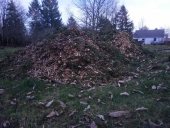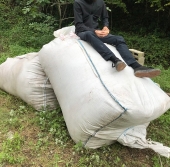I know there are people in the UK and Europe at 56N or higher, and mushrooms are likely no big deal. I am on the eastern slopes of the Rocky Mountains, and we can get 7 month winters. We can get shorter ones, but 7 is the longest I have experienced up here.
I don't think there are enough fungi on the farm, but with 40 some odd piles of wood chips that are 2 and 3 years old, I am starting to get more fungi now. This spring, I seen some kind of yellow fungal growth on my east-most mugo pine, which probably means I need to destroy (and burn it) next spring. There seem to be two possibilities, one whitches hosts from oak to pine and back, and the other is pine to pine. As there are few oaks around, I suspect it is the pine-pine variety.
But, in reading about fungi for the farm, I happened across Kind Stropharia. The Peace Country of NE BC and NW Alberta is an important place for bees worldwide, and Canada's first diagnostic imaging centre for bees is only 80 km away in Beaverlodge, Alberta. To run across a human edible mushroom which may have anti-viral efficacy for bees got my attention. So, I ordered an outdoor patch from Fungi Perfecti (fungi.com). If someone from Vancouver, BC; Seattle, WA or similar tells me that they think mushrooms will grow in Dawson Creek, I am unsure of what to think. We get significantly colder.
I cannot afford to actively heat the mushrooms in winter, so whatever I do has to be passive. I had read about shallow, frost protected foundations (slab on grade) a few years ago, and so I am applying that kind of technology to the mushrooms.
I built a 4x4 "sandbox" from 2x6 boards 3 high (so 16.5 inches). The corners have 2x2 posts sticking up about 4 feet. To have a mushroom which is good at turning wood into humis, making a wood box to contain it as a challenge.
The box is not fancy, just ordinary SPF boards (probably spruce). I primed all surfaces with BIN primer, which is based on shellac. I found a water based, one component (cured) polyurethane floor paint, which I then painted over the primer (2 coats). I bought two sheets of 3/8 outdoor plywood, and put ordinary primer on and then one coat of the same floor paint on all sides. Three of those half sheets of plywood will be sides, and the fourth (with an array of holes drilled through the roof) will be the roof. The open side will face SW, which would be a probelm except that immediately adjacent to the mushroom box is a patch of aspen to the SW.
King Stropharia will grow through about 11-12 inches of wood chips. That thickness of dry wood chips would have an R value of about R11-R12.
The 4x4 sandbox is surrounded by 4 feet of foam insulation. In house construction, the insulation is sloped to direct water away from the foundation. If the foundation is dry, even if it gets cold it can't heave. If there is a reason to vary the thickness of insulation, the thicker insulation will likely be closer to the foundation.
This is not a house. The top surface of the insulation (4x8 sheets of 3/4 inch foam) slopes towards the mushroom box, so that the box collects water from a 12x12 area, not from a 4x4 area. The thickness of insulation on the outside edge of the mushroom box is 2 inches, for an R value of about 8. If we put 14 inches of wood chips on top, that potentially gives us an R value of R22. Which is about double the possible insulation value of the mushroom/woodchip/cardboard/... bed. The outside 2 foot perimeter of this 12x12 then has a layer of 1.5 inch foam insulation. The outside 12 inches has an additional 1 inch of foam. The outside 3 inches has an additional 1 inch of foam. And then we put the 3/4 inch on top. For about 6.25 inches of foam, that is an R value of about R25. If we put 10 inches of wood chips at that edge, the wood chips would be flat on top. I want the outside edge to be slightly lower, so perhaps there is only 8 inches of wood chips at the point 4 feet away, which would have an R value of R33 (if dry). The wood chips will extend past the foam a bit, so there will be some nice transition to no insulation.
![]()
The stairstep foam around the mushroom box
Let's assume that the diameter of our final wood chips is about 17+ feet. The wood chips slope slightly to the outside, so if we get a torrential rain, there will be a tendency for immediate water to be directed away from the mushrooms (I don't think they can swim). But for a gentle rain, the water should percolate down through the chips to the foam, and be directed to the base of the mushroom box.
I filled the mushroom box a while ago, the idea being that we need to get at least 40 days of sustained above 0 temperature to establish the mushroom in the food. We had a killing frost on Aug 8 (-5C), but that won't bother things buried in mass. I started with a double layer of cardboard (copper staples removed). I had pruned a "silver" maple a bit this spring, so I had various branches up to a couple or 3 inches in diameter. I placed maple on the cardboard to sort of fill the layer, put another double layer of cardboard on, and .... I watered each layer. I did this to get to a height of about 11 inches. The void fraction of each layer was high, and being "big" pieces of wood, it won't pack well anyway. When I decided to put the "outdoor patch" into the box, the height had shrunk to about 7-8 inches. Some of the maple I collected had lichen (moss) on it, which has a fungi component. So, I didn't use lichen covered wood in building the base of the bed.
King Stropharia prefers hardwood. While I technically have lots of hardwood here (aspen, willow and poplar), I don't have any as wood chips that don't already have a huge population of fungi in it. So, I went and bought an assortment of wood chips for smoking meat (which includes maple), and I used that for what the patch sawdust was mixed with. I used a little bit of the patch sawdust just on the cardboard of the next layer (temporarily). A local farmer has a sawmill, and I managed to get maybe 1/3 of a pickup truck load of sawdust from him. Then I came back and disassembled my bed to the layer above where most of the outdoor patch was placed. I added sawdust to the layer above, put the double cardboard back on, added sawdust, ... until I got my wood bed up around 12-14 inches. And I was watering things along the way.
With no sides are roof on the mushroom box, and the typically low humidity we have (with wind), even though this year is wetter than typical; the sawdust dries out quite quickly on the top. I had applied a couple of gallons of water to the bed once before "finishing" the box. And today after putting the sides and roof on, I gave the wood pile another 2 gallons of water.
![]()
I then laid the four 3/4 inch sheets of foam around the box. At the moment, I have the front end loader (FEL) off my tractor, so I can't haul any of these fungi infested wood chips I have here to the mushroom box. So, I put a bunch of maple and cherry branches on top of the foam, mostly to keep bambi from walking on the foam.
![]()
In the late morning, early afternoon, some direct sunlight does get into the mushroom box. I plan to get some jute or burlap and put that over the open side, to reduce direct sunlight input.
Should these big mushrooms start developing next year, I will look to establish new colonies first on my lawn, and then elsewhere on the farm. Any bees visiting the neighbourhood are welcome to stop by and eat King Stropharia.
Where I have set my mushroom box, is not what Paul Stamets has envisaged. I live on the prairies, so to speak. I think most "real farmers" think I have far too many trees. I know I have too many "weeds". Leave a pasture alone for 40 years, and see what happens.
I just got a tractor about the time the outdoor patch got here (52hp). It came with a grader blade, a box blade and a subsoiler. So, preparing this site was my opportunity to learn a little about using this equipment. I've got gaps under the foam, and my "level surface" isn't big enough. Hopefully I can shore up the edges before I start putting wood chips around. I had to go deep enough to allow me to make a level surface, which meant scraping all the soil off. It is just plain clay that this is sitting on.
I have a variety of "spoils" on the periphery of the site. I am thinking that I will try to make two "temporary" ponds. I will try and make a smaller/deeper pond "above" the mushroom box, and a larger/shallower pond below. The ponds will be temporary in the sense that I do not know how long they will impound water. I suspect the water impounded will not last to freeze-up next year. But it would be nice to have an area where frogs, toads, salamanders, snakes and so on can call home. I've had visits from muskrats last year and this year at my bedroom window, so they are around.
Hmm, giving
file:/// URLs to the pictures doesn't show anything in the preview. Okay, I will submit, but maybe I need to add the 3 pictures some other way.

 1
1






















































































